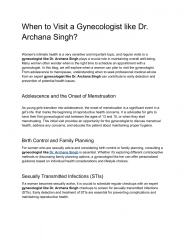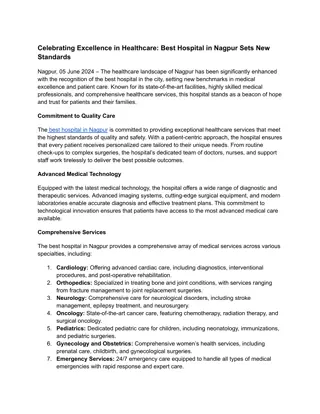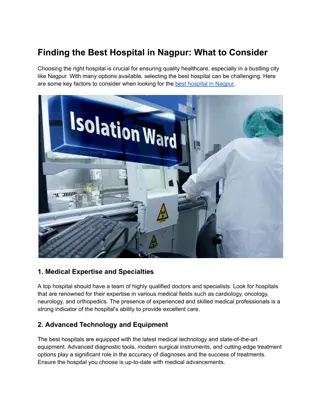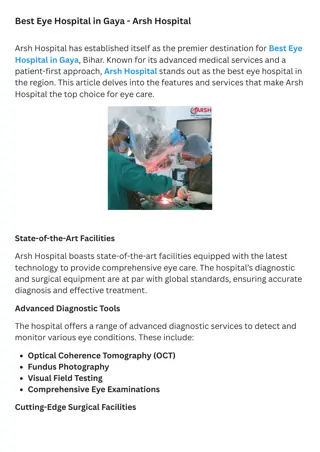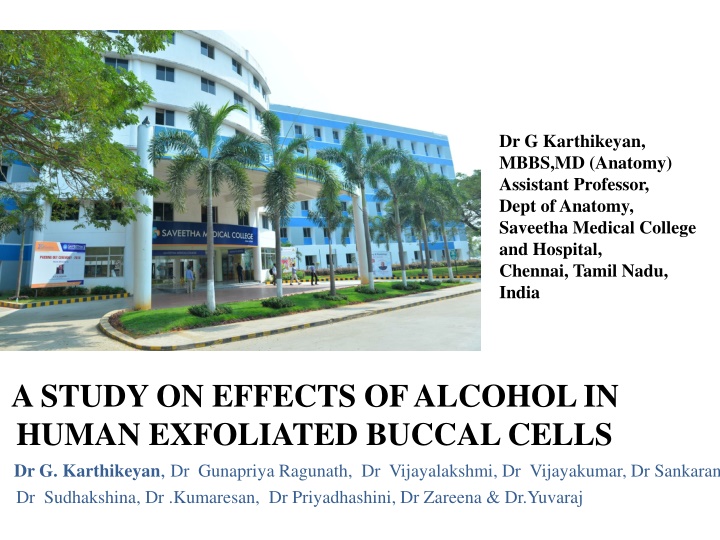
Study on Effects of Alcohol in Human Exfoliated Buccal Cells
Explore the impact of alcohol consumption on oral health through a study on micronuclei using oral exfoliative cytology. The research conducted on adult subjects aims to understand the correlation between alcohol consumption and potential health risks, particularly in the development of oral cancer. Learn about the materials, methods, inclusion criteria, and specimen collection process involved in this insightful study.
Uploaded on | 0 Views
Download Presentation

Please find below an Image/Link to download the presentation.
The content on the website is provided AS IS for your information and personal use only. It may not be sold, licensed, or shared on other websites without obtaining consent from the author. If you encounter any issues during the download, it is possible that the publisher has removed the file from their server.
You are allowed to download the files provided on this website for personal or commercial use, subject to the condition that they are used lawfully. All files are the property of their respective owners.
The content on the website is provided AS IS for your information and personal use only. It may not be sold, licensed, or shared on other websites without obtaining consent from the author.
E N D
Presentation Transcript
Dr G Karthikeyan, MBBS,MD (Anatomy) Assistant Professor, Dept of Anatomy, Saveetha Medical College and Hospital, Chennai, Tamil Nadu, India A STUDY ON EFFECTS OF ALCOHOL IN HUMAN EXFOLIATED BUCCAL CELLS Dr G. Karthikeyan, Dr Gunapriya Ragunath, Dr Vijayalakshmi, Dr Vijayakumar, Dr Sankaran Dr Sudhakshina, Dr .Kumaresan, Dr Priyadhashini, Dr Zareena & Dr.Yuvaraj
INTRODUCTION Cancers are the most commonest cause of death in adults. Oral cancer is among the top three cancers in India. Oral cancer is any malignant neoplasm which is found on the lip, floor of the mouth, cheek lining, gingiva, palate or in the tongue (primary site)
RISK FACTORS World-wide, 48% of the total adult population (approximately 2 billion people) consume alcohol and 33% (approximately 1.3 billion people) consume tobacco. Betel nut chewing and human papilloma virus(HPV) Oral cancer may also occur due to poor dental care and poor diet Genotoxic agents can causes carcinogenic damage to the chromosomes and form several secondary nuclei known as micronuclei.
AIM OF THE STUDY To study the micronuclei using oral exfoliative cytology in alcoholic subjects.
MATERIALS AND METHODS This prospective study was conducted in 332 adult subjects between the age 30-50 years, they were divided into three groups Group 1- control subjects(n=120) had no habit of alcohol and cigarettes smoking Group 2- Subjects present only with habit of alcohol consumption (n= 110) Group 3- Subjects present with habit of both alcohol consumption & cigarettes smoking (n=102)
INCLUSION CRITERIA More than 10 years of alcohol consumption ( Regular or occasional ) Habit of smoking ( Regular or occasional) EXCLUSION CRITERIA Any oral pathology Poor diet Any oral substance abuse ( betel nut, hans, pan masala, kutka) Under any medication
COLLECTION OF SPECIMENS The material was collected from the oral cavity by scraping the buccal mucosa on the cancer prone area using a clear wooden spatula Scraped material was spread on the precleaned slide and fixed with methanol and glacial acetic acid for 20 minutes. These fixed slides were stained with Giemsa stain and studied for presence of micronuclei.
Statistical analysis One way ANOVA P value less than 0.05 considered to be significant
RESULTS AND DISCUSSION Presence of micronuclei in group 2 is significantly increased when compared to group 1 But not significantly increased between group 2 & group 3 Group 1 Group 2 Group 3 Total No of subjects 120 110 102 No of subjects showing micronucleus in buccal mucosa 11 80 97
Buccal smear (Giemsa staining) A - CONTROL GROUP B - CONTROL GROUP SHOWING MICRONUCLEUS B A C - GROUP 2( ALCOHOLIC) presence of more micronucleus D= GROUP 3( ALCOHOLIC+ SMOKING) presence of numerous micronucleus D C
DISCUSSION Micronucleus test on the buccal mucosa is useful to examine an early cellular response to any carcinogens This study clearly demonstrated that MN frequencies were significantly increased in alcoholic subjects with increased incidence of oral cancer.
Factors favouring formation of micronucleus in alcoholics Dehydrating effect of alcohol on cell Nutritional deficiencies associated with heavy drinking Enhances the ability of other carcinogens to permeate Lack of antioxidants
Only 11 out of 120 subjects in control group showed micronuclei This may be due to drugs, viral infections, environmental pollutants. 80 smears out of 110 alcoholic subjects showed micronuclei indicating higher risk of developing oral cancers.
97 smears out of 102 subjects with both alcohol consumption and smoking showed more micronuclei. Which further increases the risk of developing oral cancers.
MICRONUCLEI Cell division Alcohol Genotoxic agents Alcohol Tobacco HPV Betal nut chewing Damage to the chromosome Deficiency in dietary folate and vitamin B12 Chromosomal fragments (Lag behind in anaphase) Lagging elements will be included in daughter cells Secondary nuclei
There is evidence that deficiency in dietary folate and vitamin B12 may also increase in occurrence of MN Localized folate deficiency induced by alcohol consumption can cause micronuclei in buccal mucosa cells which is independent of the plasma folate level. Plasma and buccal mucosal levels of folate and vitamin B12 were however, not assessed in the present study.
It is evident from our study, that alcohol consumption is a high risk for development of the oral cancer The frequency of MN is further increased by the habit of cigarette smoking increasing the risk further. It cannot be concluded that oral carcinoma will arise from these sites. The possibility to quantitative genotoxic damage in various tissues will make this approach applicable for a wide spectrum of studies on human population groups.
CONCLUSION There is a high increase in micronuclei in alcoholic subjects which is aggravated by smoking than that of controls. This concludes that MN assay can be used as a biomarker for detecting the progression of cancer and can be used as a screening test in the population at risk.
REFERENCES 1. Rajesh Dikshit, Prakash C Gupta, Chinthanie Ramasundarahettige, Vendhan Gajalakshmi, Lukasz Aleksandrowicz, Rajendra Badwe, Rajesh Kumar, Sandip Roy, Wilson Suraweera, Freddie Bray, Mohandas Mallath, Poonam K Singh, Dhirendra N Sinha, Arun S Shet, Hellen Gelband, Prabhat Jha for the Million Death Study Collaborators, "Cancer mortality in India: a nationally representative survey" J. K. Elango, P. Gangadharan, S. Sumithra, and M. A. Kuriakose, Trends of head and neck cancers in urban and rural India, Asian Pacific Journal of Cancer Prevention, vol. 7 Moshberg , Merletti F, Boffetla P, Gandolfo S, Ozzellon F, Pracchia F, et al. Appearance, site of occurrence, and physical and clinical characteristics of oral carcinoma in Tornio, Italy. Cancer, 1989; 63(12): 2522-2527. Anil K. Chaturvedi, William F. Anderson, Joannie Lortet-Tieulent, Maria Paula Curado, Jacques Ferlay, Silvia Franceschi, Philip S. Rosenberg, Freddie Bray, and Maura L. Gillison, "Worldwide Trends in Incidence Rates for Oral Cavity and Oropharyngeal Cancers PLopez Jornet,* FJ Gomez Garcia,* M Lucero Berdugo,* F Parra Perez,* A Pons-Fuster Lopez, "Mouth self-examination in a population at risk of oral cancer Wen-JiunLin,1 Rong-SanJiang,1 Shang-HengWu,1 Fun-JouChen,2 andShih-AnLiu1,3, "Smoking,Alcohol, andBetel QuidandOralCancer: AProspective CohortStudy Fenech M., Browne RM, Camsey MC, Waterhouse JAH, Manning GL. Etiological Factors in oral squamous cell carcinoma. Comm Dent Oral Epidemiol, 1977; 5(6): 301-306. Garewal HS, Ramsey L, Kaugars G, Boyle J. Clinical experience with the micronucleus assay. J Cellul Biochem, 2004; 53(17): 206-212. Halder A, Chakraborty T, Mandal K, Gure PK, Das S, Ray Chowdhury R, et al. Comparative study of Exfoliated oral mucosal cell micronuclei frequency in normal. Precancerous and malignant epithelium. Int J Hum Genet, 2004; 4(4): 257- 260. Proja NK. Paszkuioizc GM, Nasca MA, Franke GE, Pauly JL. Smoking and smokeless tobacco- associated human buccal cell mutations and their association with oral cancer - A Review. Cancer Epidemiol Biomark Prev, 2006; 15(6): 1061-1077. Pawitan JA. Biological tests for mutagenesis in man. A Clinical Review. Medical progress, 1999; 16-18 Yadaw JS, Chadha P. Genotoxic studies in Pan Masala chewers: A high cancer risk group. Int J Hum Genet, 2002; 2(2): 107- 112. Stich HJ, Curtis JR, Parida BB. Application of the micronucleus test to exfoliated cells of high cancer risk groups; tobacco chewers. Int J Cancer, 1982; 30(5): 553-559. 2. 3. 4. 5. 6. 7. 8. 9. 10. 11. 12. 13.
MICRONUCLEI Micronuclei are extra-nuclear cytoplasmic bodies; they are induced in cells by numerous genotoxic agents that damage the chromosomes including alcohol and tobacco. The damaged chromosomes, in the form of a chromosome fragments, lag behind in anaphase when centric elements move towards the spindle poles. After telophase, the undamaged chromosomes, give rise to regular daughter nuclei.[7,8,9]
The lagging elements are included in the daughter cells, but a considerable proportion is transformed into one (or) several secondary nuclei, much smaller than the principle nucleus and is therefore called micronuclei [7,8,9] Useful biomarker to assess cytogenetic damage in biomonitoring studies using peripheral lymphocytes and epithelial cells
It is evident from our study, that in alcohol consumption, the buccal mucosa are at high risk for development of oral cancer, showing an increase in the MN frequencies, which is further increased by the habit of cigarette smoking. However, it cannot be concluded that oral carcinoma will arise from these sites. The possibility to quantitate genotoxic damage in various tissues will make this approach applicable for a wide spectrum of studies on human population groups.
Micronuclei are induced in oral exfoliated cells by a variety of substances, including genotoxic agents and carcinogenic compound in tobacco, betal nut and alcohol [10]. With this view in mind, the present study was carried out to assess the occurrence and compare the levels of micronuclei in oral exfoliative cytology of healthy control subjects and subjects presenting with habit of alcohol consumption.
EFFECTS OF ALCOHOL COMSUMPTION Alcohol s effect on the mouth may be the key to understanding how it works with tobacco to increase the risk of developing cancer. The dehydrating effect of alcohol on cell walls enhances the ability of tobacco carcinogens to permeate mouth tissues; additionally, nutritional deficiencies associated with heavy drinking can lower the body s natural ability to use antioxidants to prevent the formation of cancers.
EFFECTS OF ALCOHOL COMSUMPTION Alcohol s effect on the mouth may be the key to understanding how it works with tobacco to increase the risk of developing cancer. The dehydrating effect of alcohol on cell walls enhances the ability of tobacco carcinogens to permeate mouth tissues; Additionally, nutritional deficiencies associated with heavy drinking can lower the body s natural ability to use antioxidants to prevent the formation of cancers.
These agents damage the chromosomes to form several secondary nuclei known as micronuclei. This study identifies the occurrence of micronuclei and also evaluates the frequency of micronuclei in stained smears of oral exfoliative cells from healthy subjects and alcoholic subjects.
The increase in MN may be due to induction of cytogenetic damage in the epithelium by carcinogenic agents released from alcoholic consumption. Hence the micronucleus assay can be used as a biomarker of genotoxicity in predicting effects of carcinogenic agents.
Discussion Micronuclei has been proposed as a useful biomarker to assess cytogenetic damage in biomonitoring studies using peripheral lymphocytes and epithelial cells [8, 9]. Segregational defects are considered to be one of the causes for chromosomal instability, where centric and a-centric micronuclei are formed during telophase [3, 9]. Mammalian tissue exposed to various chemical or physical carcinogens show a great variety of nuclear anomalies and mitotic irregularities producing extra- nuclear DNA containing bodies like micronuclei formed by classical mechanisms [10]. The sensitivity of the micronucleus test is

